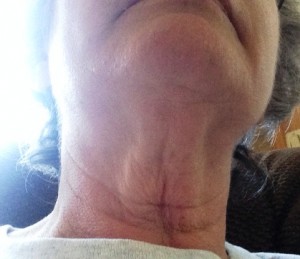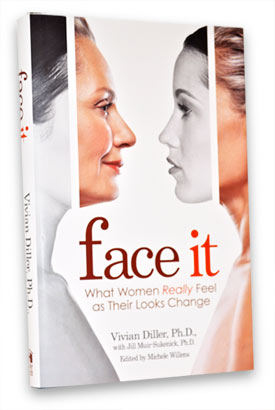A few years ago I read the collection of humorous essays by Nora Ephron titled “I Feel Bad About My Neck.” I enjoyed the book, but didn’t quite understand the focus on the neck. Why should the neck, more than any other body part, be singled out as a sign of aging? Just three short years later, I understand as I play with the developing wattles along my neck every time I pass a mirror.

This is the reason I got the book “Face It: What Women Really Feel As Their Looks Change” from the library. It was written by two women, Vivian Diller and Jill Muir-Sukenick, with Ph.D.s in psychology. That the women are former models and also dealing with aging was helpful as I read the case studies and suggestions of the psychologists.
Diller and Muir-Sukenick go beyond quick fixes to examine the influences in our past that determine how we feel about our looks and how those feelings can be masked or unearthed as we get older. Dealing with these feelings in healthy ways can help us survive with our self-esteem intact in a society that seems to value youthful good looks over all other values.
Diller and Muir-Sukenick suggest six steps to work through that help us accept who we are and how we look as we age.
1. “Turn your uh-oh moments into ah-ha ones!” There comes a point where we can’t ignore the aging process any longer – when we suddenly realize that we look old. How do we deal with these moments?
2. “The only mask you wear should be made of honey and yogurt!” We can turn to plastic surgery or to wearing clothes that are age-inappropriate, but these are masks that hide who we are and turn brittle and ugly with age.
3. “Talk back to those internal dialogues.” We’ve all done it – looked at ourselves in the mirror and imagined that we are hideous or invisible to others. What conversations do you imagine? Would they be ridiculous if you voiced them aloud to someone who loves you – a friend or spouse?
4. “Give Mom her due. Take the best of her and leave the rest behind.” Many times we take our cues about our looks from our mothers and our families of origin. The old family labels can cause you to be stuck in the past and keep you from dealing with the present – and future.
5. “Using adolescent memories instead of repeating them.” How did you deal with your changing looks at puberty? There may be parallels between then and your changing looks now. Recognizing the similarities helps us break out of self-destructive patterns from the past.
6. “Saying Good-bye is hard to do.” We may mourn the loss of our looks (that smooth neck) but we also need to embrace a more flexible self-image. There really are more important things in our lives than our looks. How are you re-inventing yourself every day?
The best part of the book is the questions at the end of each step, and an appendix questionnaire at the back, that would be excellent for a women’s book study. I would love to read this with a group of other women in their 50’s and talk about the questions together.
“Face It” was a helpful book as I think about my neck. It will only be downhill from here! But that doesn’t mean my life will be downhill! I am blessed by good genes from my parents who are still beautiful in their late 70s. I have a husband who thinks I am beautiful and tells me every day. But even more importantly, my worth comes from what I do and how I serve God, not how I look. When we are more interested in others than we are in ourselves, our faces will be attractive to those others no matter how old and wrinkled we are.
